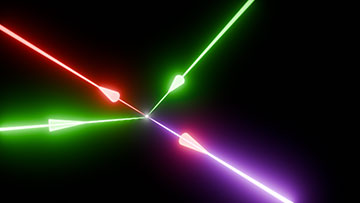
Scientists have modeled photon‒photon scattering involving three input beams (shown here in green and red) and an output beam (blue). They say their results should help future experiments seeking to probe the quantum vacuum with very powerful lasers. [Image: Zixin (Lily) Zhang]
Scientists in the United Kingdom and Portugal report that they have for the first time simulated how intense laser pulses interact with the quantum vacuum in three dimensions (Commun. Phys., doi: 10.1038/s42005-025-02128-8). They say their results could help guide the execution of vacuum experiments with a new generation of very powerful lasers starting up over the next few years.
A new generation of lasers
The theory of quantum electrodynamics tells us that the vacuum is not empty space, as it is assumed to be classically, but is instead teeming with pairs of oppositely charged virtual particles popping into and out of existence (in line with Heisenberg's uncertainty principle). This “quantum vacuum” creates nonlinearities that modify the properties of propagating laser beams and should yield measurable effects when the beams are suitably intense.
That is the basis for planned experiments at a number of new lasers with powers in the petawatt (PW; 1015 W) range that have either recently been switched on or are being built. Such lasers include two 10-PW beams in Romania as part of the Extreme Light Infrastructure, the 20-PW Vulcan 20-20 laser in the United Kingdom and two 25-PW beams proposed as part of the EP-OPAL project in the United States. Even more intense will be a 100-PW beam at the Station of Extreme Light, which is part of the SHINE X-ray free electron laser under construction in China.
Interpreting the results from these experiments will require comparing them with theory, but analytical models can currently only make predictions about certain types of laser—namely those generating beams with Gaussian-shaped cross-sections that remain close to the optical axis. At the same time, simulations of vacuum interactions have to date mainly been limited to two dimensions.
In the latest work, Peter Norreys, Zixin Zhang and colleagues at the University of Oxford, UK, working with Luis Silva and coworkers at the University of Lisbon, Portugal, have shown how to carry out real-time simulations in three dimensions. They did so using a numerical “solver” based on modified Maxwell's equations, which approximates the nonlinearities in a quantum vacuum by linearly interpolating the classical values of the electric and magnetic fields at each point in space for a series of time steps. The scientists ran their solver on a relativistic particle-in-cell program called OSIRIS.
Vacuum birefringence
The relative simplicity of vacuum birefringence meant that the researchers could compare their simulations directly with analytical theory.
Norreys and colleagues simulated two types of nonlinear interaction. The simpler of these was vacuum birefringence, which involves the different polarization components of a laser pulse running out of phase with one another as the pulse travels through a strong electromagnetic field. This phenomenon causes a linearly polarized pulse to gain a very slight polarization in the orthogonal direction, an effect known as ellipticity.
The relative simplicity of vacuum birefringence meant that the researchers could compare their simulations directly with analytical theory. They did so by modeling a probe pulse directed at a stronger pump pulse, calculating the polarization ellipticity at many points on the collision plane and then comparing these values with ones calculated from theory. Doing so for both plane waves and Gaussian pulses, the team found a variation from theoretical predictions of no more than 2% or 3%.
Four-wave mixing
With this result in the bag, Norreys and coworkers went on to study the trickier but more interesting phenomenon of four-wave mixing. The nonlinearities in this case cause interactions between photons in three different focused laser pulses, causing a fourth pulse to appear as if from nowhere—with the properties of that beam dictated by the conservation of energy and momentum.
The complexity of four-wave mixing means that analytical theory can only provide predictions for the simple case of interacting plane waves and loosely focused Gaussian beams. This made it more complicated for the researchers to compare theory against the results of their simulations, which featured more realistic Gaussian beams. Instead, they checked their data against those from previous simulations, finding good agreement when allowing for differences in beam parameters.
The Oxford‒Lisbon collaboration says that its four-wave mixing simulations not only provide detailed information about the output pulse's temporal evolution but also reveal how the properties of that pulse can be shifted significantly by tiny changes to the input beams. They also argue that the new results can help better prepare future experiments, explaining, for example, that precise estimates of the output pulse's speed and direction could help to improve signal-to-noise ratios by excluding all detector data that fall outside a specific temporal window.
What’s more, the researchers say that the new approach could be used to study the quantum vacuum’s effect on novel pulse shapes, including very tightly focused beams. They also reckon that their solver could elucidate light–vacuum interactions in the presence of particles generated by Compton scattering and other background effects, opening the way, they say, “to full-scale modeling of upcoming all-optical photon‒photon scattering experiments.”

